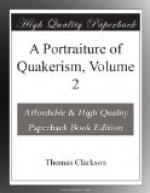[Footnote 187: Chap. 11.]
But whichever ceremonial it was that St. Paul alluded to, the circumstances of the irregularities of the Corinthians, obliged him to advert to and explain what was said and done by Jesus on the night of the passover-supper. This explanation of the Apostle has thrown new light upon the subject, and has induced the Quakers to believe, that no new institution was intended to take place as a ceremonial to be observed by the Christian world.
St. Paul, in his account of what occurred at the original passover, reports that Jesus Christ made use of the words “this do in remembrance of me.” By this the Quakers understand that he permitted something to be done by those who were present at this supper.
He reports also, that Jesus Christ used these words, not only after the breaking of the bread, but after the giving of the cup: from whence they conclude, that St. Paul considered both the bread and the wine, as belonging to that which had been permitted.
St. Paul also says, “for as often as ye eat this bread and drink this cup, ye do show the Lord’s death till he come.” By these words they believe they discover two things; first, the nature of the thing permitted; and, secondly, that the thing permitted, whatever it was, was to last but for a time.
The thing then, which was permitted to those who were present at the passover-supper, was to show or declare his death. The words “show or declare,” prove, in the first place, the connexion of the thing permitted with the Jewish passover. For after certain ceremonies had been performed on the passover night, “the showing forth or declaration,” as it was called, followed; or the object of the meeting was declared aloud to the persons present, or it was declared to them publicly in what particulars the passover feast differed from all the other feasts of the Jews. Secondly, the word “death” proves the thing permitted to have been the passover, as spiritualized by Jesus Christ; for by the new modification of it, his disciples, if they were unable to overcome their prejudices, were to turn their attention from the type to the antitype, or from the sacrifice of the paschal lamb to the sacrifice of himself, or to his own sufferings and death. In short, Jesus Christ always attempted to reform by spiritualizing. When the Jews followed him for the loaves, and mentioned manna, he tried to turn their attention from material to spiritual bread. When he sat upon Jacob’s well, and discoursed with the woman of Samaria, he directed her attention from ordinary, or elementary to spiritual and living water. So he did upon this occasion. He gave life to the dead letter of an old ceremony by a new meaning. His disciples were from henceforth to turn their attention, if they chose to celebrate the passover, from the paschal lamb to himself, and from the deliverance of their ancestors out of Egyptian bondage to the deliverance of themselves and others, by the giving up of his own body and the shedding of his own blood for the remission of sins.




